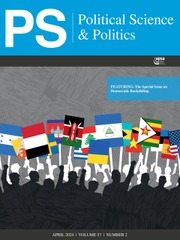Article contents
Teaching Critical Analysis Skills with Analysis Briefs:What They are and How They Work
Published online by Cambridge University Press: 11 January 2008
Extract
Critical analysis, which is defined as the reasoned and logicalprocess of skillfully conceptualizing, applying, analyzing,synthesizing, and/or evaluating information (Scriven and Paul 2001), is at the heart of the researchprocess that propels our profession's knowledge-base forward. Inthis essay, I describe an effective method that I developed to helpinculcate and hone students' critical analysis skills. Indeed,critical analysis skills are crucial foundational skills necessaryfor all students, especially those who intend to thrive successfullyas researchers in our profession.I amgrateful to A.B. Assensoh, Joan Middendorf and the threeanonymous reviewers, respectively, who offered helpful commentson earlier versions of this essay.
Information
- Type
- THE TEACHER
- Information
- Copyright
- © 2008 The American Political Science Association
References
- 5
- Cited by

